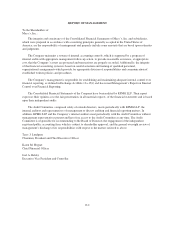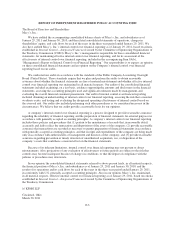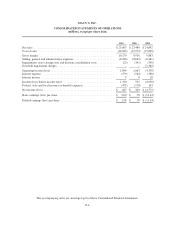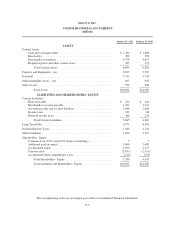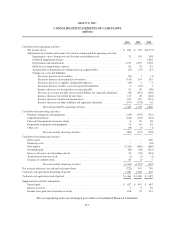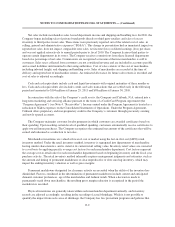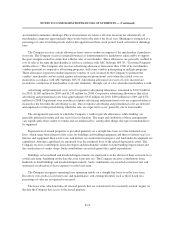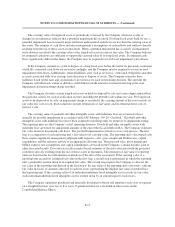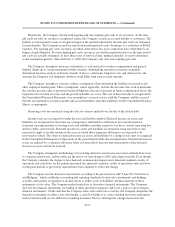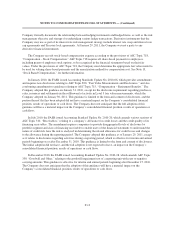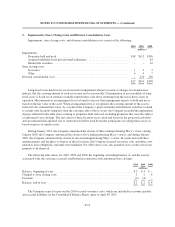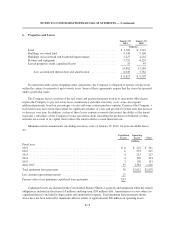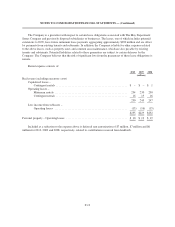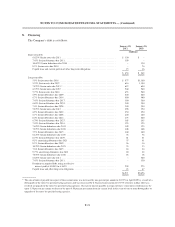Macy's 2010 Annual Report Download - page 60
Download and view the complete annual report
Please find page 60 of the 2010 Macy's annual report below. You can navigate through the pages in the report by either clicking on the pages listed below, or by using the keyword search tool below to find specific information within the annual report.
NOTES TO CONSOLIDATED FINANCIAL STATEMENTS — (Continued)
Historically, the Company offered both expiring and non-expiring gift cards to its customers. At the time
gift cards are sold, no revenue is recognized; rather, the Company records an accrued liability to customers. The
liability is relieved and revenue is recognized equal to the amount redeemed at the time gift cards are redeemed
for merchandise. The Company records income from unredeemed gift cards (breakage) as a reduction of SG&A
expenses. For expiring gift cards, income is recorded at the end of two years (expiration date) when there is no
longer a legal obligation. For non-expiring gift cards, income is recorded in proportion and over the time period
gift cards are actually redeemed. At least three years of historical data, updated annually, is used to determine
actual redemption patterns. Since February 2, 2008, the Company sells only non-expiring gift cards.
The Company, through its insurance subsidiaries, is self-insured for workers compensation and general
liability claims up to certain maximum liability amounts. Although the amounts accrued are actuarially
determined based on analysis of historical trends of losses, settlements, litigation costs and other factors, the
amounts the Company will ultimately disburse could differ from such accrued amounts.
The Company, through its actuaries, utilizes assumptions when estimating the liabilities for pension and
other employee benefit plans. These assumptions, where applicable, include the discount rates used to determine
the actuarial present value of projected benefit obligations, the rate of increase in future compensation levels, the
long-term rate of return on assets and the growth in health care costs. The cost of these benefits is recognized in
the Consolidated Financial Statements over an employee’s term of service with the Company, and the accrued
benefits are reported in accounts payable and accrued liabilities and other liabilities on the Consolidated Balance
Sheets, as appropriate.
Financing costs are amortized using the effective interest method over the life of the related debt.
Income taxes are accounted for under the asset and liability method. Deferred income tax assets and
liabilities are recognized for the future tax consequences attributable to differences between the financial
statement carrying amounts of existing assets and liabilities and their respective tax bases, and net operating loss
and tax credit carryforwards. Deferred income tax assets and liabilities are measured using enacted tax rates
expected to apply to taxable income in the years in which those temporary differences are expected to be
recovered or settled. The effect on deferred income tax assets and liabilities of a change in tax rates is recognized
in the Consolidated Statements of Operations in the period that includes the enactment date. Deferred income tax
assets are reduced by a valuation allowance when it is more likely than not that some portion of the deferred
income tax assets will not be realized.
The Company changed its methodology for recording deferred state income taxes from a blended rate basis
to a separate entity basis, and has reflected the effects of such change to 2010 and all prior periods. Even though
the Company considers the change to have had only an immaterial impact on its financial condition, results of
operations and cash flows for the periods presented, the financial condition, results of operations and cash flows
for the prior periods as previously reported have been adjusted to reflect the change.
The Company records derivative transactions according to the provisions of ASC Topic 815 “Derivatives
and Hedging,” which establishes accounting and reporting standards for derivative instruments and hedging
activities and requires recognition of all derivatives as either assets or liabilities and measurement of those
instruments at fair value. The Company makes limited use of derivative financial instruments. The Company
does not use financial instruments for trading or other speculative purposes and is not a party to any leveraged
financial instruments. On the date that the Company enters into a derivative contract, the Company designates the
derivative instrument as either a fair value hedge, a cash flow hedge or as a free-standing derivative instrument,
each of which would receive different accounting treatment. Prior to entering into a hedge transaction, the
F-12


